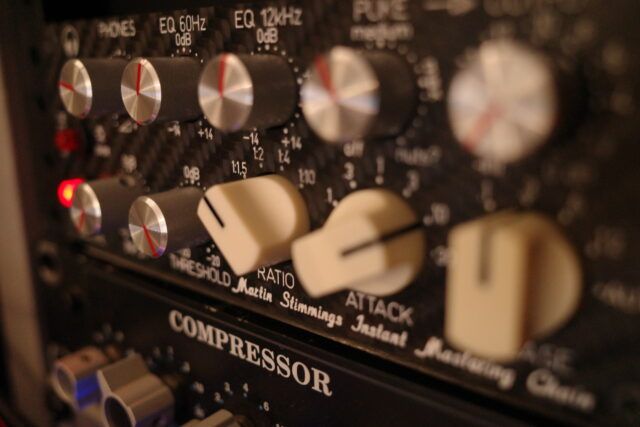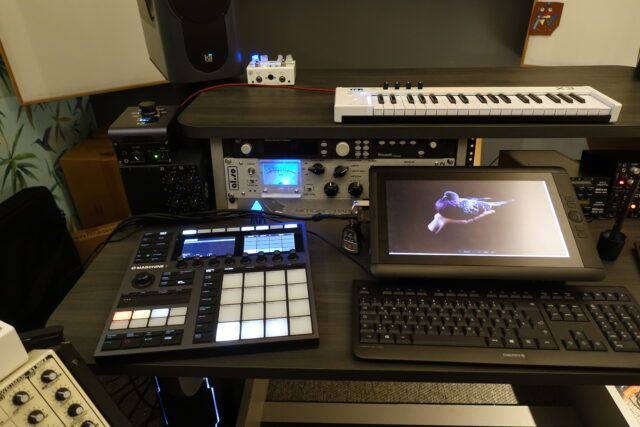Hamburg-based electronic music producer Stimming has made quite the impact over the years with his uniquely intriguing take on house music and mesmerizing live performances. We got to know a bit about his production process back in 2015 (check out his How I Play), and he has undoubtedly continued to evolve his sound to push beyond boundaries. Six years later, we checked back in with Stimming to learn about his forthcoming album Ludwig, the thinking behind the latest iteration of his sound, and more.
Let’s dive in.
First off: tell us about Ludwig, and the inspiration behind its creation.
Hey, thanks for having me! Ludwig is the second name of my second son, which implies the personal stories behind the album and each track. Becoming a father, growing a family, ultimately becoming an adult (somewhere in the mid-thirties, better late than never ;)) is probably the deeper sense behind the music – with all its difficulties, fears, letdowns, and gains. I carried the idea of doing an album that doesn’t rely on pure four/four beats and somewhat connects to my second album Liquorice, but with… friendlier ideas for a couple of years already.
With this album, you mention you’re “not interested in functionality anymore – at least not for now.” Can you elaborate on what that means in regards to its production?
Well, when you do dance music in the broadest sense, the function of the music first and foremost is to make people dance. In techno, the dance function relies on the four/four bass drum to make it mixable, danceable, predictable, and well, it’s techno, we all know what this means. So, getting rid of the strongly predictable bass drum also means not fulfilling the function anymore, which opens up a totally new field of possibilities – if, as a house producer, this is manageable. I don’t want to lead too far away from the question, but there’s something very strange about those strict four/four beats as they are difficult to build in an artful way and I needed a very long time to “learn” how to build a proper house track. Now that I’m leaving that scheme, again, it was very difficult to find energy and interest in something much freer.
We’d love to hear more about the production process behind Ludwig. What hardware + software did you use, and why choose those items? What did your ideation + creation process look like?

On the hardware + software:
The core of my setup is Bitwig in touchscreen mode, running on a very fast Windows PC on 96kHz and a roundtrip latency of 4ms. My converter is a merging Hapi and I listen through either Kii three speakers, Shure KSE1500 in-ears, or the classic Sony MDR 7506. The Hapi has 16 ins and 8 outs: 8 ins and outs for outboard gear, my own “instant mastering chain” which I used on every beat-group on the album (I group-print a lot), the API 2500 that I’ve owned for a long time and cannot get rid of it (I tried ;)), my al.so dynax2 (“clean as clean can be” – optical compression), and the specular tempus reverb pedal.
Speaking of reverb: part of my core setup always is – and since my third album, has been – the Bricasti m7, which is still the best-sounding reverb I know of. The other eight inputs are pretty much freely assigned with my fine collection of a hardware synth, depending on what I needed for the idea I was working on. I tend to use input 9 and 10 for mics, 15 for the Pulsar23 and 16 for my Cwejman S1 – but this is not fixed and can easily be changed.
On the software side, I am an easy guy who doesn’t like to fill the plugin folder more than necessary. The dmg audio equilibrium is my go-to eq (from time to time I ask my mastering engineer if there is something better and until now he denied so I’m fine), I usually compress with the “tool” and the audio-sidechain modulator in Bitwig. For effects, I use quite a lot of Soundtoys and also like what Puremagnetik does. Synth-wise I used cypher2, quanta, pigments, and the internal (very powerful) sampler from Bitwig.
On the production process:
The creation process was quite a long one, and effectively started at the beginning of 2018. I was looking for a way to expand the little musical ideas that I had already collected over time. This could be a found sound, a little chord progression, a melody that I hummed (track: “Arc de Triomph”), or anything like that. But getting to a point where I felt this could work needed a year, and started in spring of 2019 when I made what became the second track: “Pidgeons feat. Balbina” – a trip-hop-influenced stumbler with me singing a choir (the main singer came afterward), using the beloved Microfreak in combination with a pigeon-found-sound and real recorded drums.
Of the 12 tracks, which track stands out to you the most? Why so?
“9pm” was finished on my Surface Pro computer, a portable Windows tablet that is able to run Bitwig (on which I mirrored my projects). I was playing in Zürich on that day, one of the five gigs I played in 2020 (usually it’s at least 50), and the gig was very strange. But afterward, I took the chance to work further on the track in the hotel room and found a way of making it …well, the way it is. Cold air is breaking into an already-melancholic theme, leaving you alone with a pitched piano that makes me shiver still. What I figured out in the hotel room was to do this very fast so the listener doesn’t have time to wander into something else with his mind. When I started this track (the “star-sound” is probably the Paulstrecht’ed violin, which is heard in real as well as an FX), it was the first weekend for the pandemic trouble we all got rushed into. I was reading the news that practically all airplanes were grounded and it was then that I realized how big of a challenge awaited us. It really had that “zombie-apocalypse” feeling, and I’m quite sure a lot of people felt the same.
I was sitting in the studio and trying to do the soundtrack for this. From the album’s dramaturgy, it sits in the middle and reflects the trouble breaking in. From there, it goes down the ladder while finding a way back to resilience (such a modern word!) three tracks later.

Ludwig integrates many intriguing sound elements – for example, the buzzing in “The Hyve” and what sounds like a violin or guitar plucking in “Circle Of Thirds”. When crafting the album, what was your thought process with including these sounds? How did you create & integrate them?
This wasn’t very different from what I did before. In music-making, what interests me the most always is making a machine sound human. For this, I pretty much combine a somewhat “real” sound (the guitar pluck in Circle of Thirds is my friend Johannes Brecht playing the acoustic bass, for example) with a synth. I do this with percussions where analog synth sounds (i.e. a pinged filter) have a found-sound played over top, or a rhythmic pattern is replayed by my hands and then used as a modulator for another track that reacts to the pattern. With synth sounds, it seems to work very well when two synthesis methods are combined – Cypher2 and Vermona Perfourmer, for example. The buzzing on the hyve are real bees that I recorded in (!) my father’s beehives, so for this sound I decided to leave it just the way it is, as it’s so impressive having bees flying around your head so closely. I put the mics (a pair of Lom Audio Mikro UZIs running into my Mixpre3) in front of the hive and, later on in the track, also IN it. The somewhat factory-sounds at the end of the track are the sound of bees inside the hive only – there was no noise coming from the outside!
After Ludwig, what’s next for you as an artist? What projects do you look forward to working on in the upcoming year or two?
Right now, I am working on my next album (which will carry the second name of my first son) and, of course, I’m open to where this leads me. Allowing me the freedom to not fulfill the functionality opened up a broad horizon and the little boy in me who is still there (you meet him in my gear-reviews) wants to discover!
Also, the “instant mastering chain” that I mentioned earlier is a portable, very good-sounding hardware device that will come out later this year. I designed the specs and the final sound together with a guy called Doctron, who is hand-making those in Germany for European customers (for now). If the actual part-shortage will allow, we will launch the device at this year’s super booth. It’s originally made for the hardware-only live set to sound thick and fat so the performer doesn’t need to fear the DJ who is playing before him, but it proved to be very useful in the studio as well. I’m looking forward to selling these, discovering new musical grounds and seeing my children grow.
Stimming’s new album, Ludwig, is out now. You can listen to the album and purchase it here.





